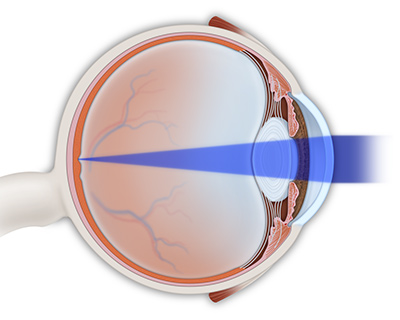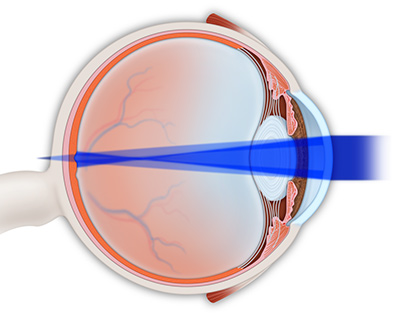What is Astigmatism?
Astigmatism is an imperfection in the curvature of your eye’s cornea or lens. Normally, the cornea and lens are smooth and curved equally in all directions. This helps to focus light rays sharply onto the retina at the back of your eye. If your cornea or lens isn’t smooth and evenly curved, light rays aren’t refracted (bent) properly. This is a type of refractive error.
When your cornea has an irregular shape, you have corneal astigmatism. When the shape of your lens is distorted, you have lenticular astigmatism. In either case, your vision for both near and far objects is blurry or distorted. It’s almost like looking into a fun house mirror in which you can appear too tall, too short, too wide or too thin.
People may have astigmatism along with other refractive errors. Those errors may include things like: nearsightedness (myopia) or farsightedness (hyperopia).
Adults with significant astigmatism may realize their vision isn’t as good as it should be. Children with astigmatism symptoms may not be aware they have this condition. They are unlikely to complain about blurred or distorted vision.In astigmatism, images focus in front of and beyond the retina. Close and distant objects both appear blurry.
Uncorrected astigmatism can impact a child’s ability to achieve in school and sports. It is crucial that children have regular eye exams. Get these exams to detect astigmatism and other vision problems as early as possible.
Astigmatism is caused by an irregular curvature of the eye’s cornea or lens. If your cornea or lens isn’t evenly curved, light rays aren’t refracted properly. With astigmatism you have blurred or distorted vision at near and far distances.

Normal Eye without Astigmatism-
Images focus perfectly on the retina.

Eye with Astigmatism-
Images focus both in front of and behind the retina,
leading to a blurred image.
Astigmatism is very common. Doctors don’t know why corneal shape differs from person to person. They do know that likelihood of developing astigmatism is inherited.
Astigmatism can develop after an eye disease, eye injury or surgery. It is a myth that astigmatism can develop or worsen from reading in low light or sitting very close to the television.
Astigmatism symptoms may include:
- blurry vision or areas of distorted vision
- eyestrain
- headaches
- squinting to try to see clearly, or
- eye discomfort
If you have these symptoms you may not necessarily have astigmatism. You should visit Dr. Banik and a complete eye exam will determine what is causing your symptoms.
Your Astigmatism Prescription: What Do These Numbers Mean?
After an eye exam, if you have a significant astigmatism, Dr. Banik may hand you a prescription. But have you ever tried to read it?
Ophthalmologists and optometrists sometimes use different measurements for astigmatism. The opticians who work in optical shops will make and fit your glasses or contacts off the numbers from the prescription
Astigmatism is measured in diopters. A perfect eye with no astigmatism has 0 diopters. Most people have between 0.5 to 0.75 diopters of astigmatism. People with a measurement of 1.5 or more typically need contacts or eyeglasses to have clear vision.
Of the three numbers on your contacts or glasses prescription, the last two refer to astigmatism:
- “Spherical” indicates whether you are nearsighted or farsighted. A plus sign indicates you are farsighted, a minus sign indicates you are nearsighted. The higher the number, the stronger your prescription.
- “Cylinder” measures what degree of astigmatism you have, or how flat or irregular your cornea is shaped.
- “Axis” is measured in degrees, and refers to where on the cornea the astigmatism is located. Axis numbers go from 0 to 180.*
*Adapted from www.aao.org
